DPS places a high priority on its
responsibilities for management of the environmental and heritage
aspects of Parliament House.
Environmental reporting information
in this part is structured using the core Global Reporting
Initiative (GRI) environment performance indicators (www.globalreporting.org).
DPS manages and reports on the
environmental and heritage aspects for the whole of Parliament
House. In some cases this includes information from the Department
of the Senate and the Department of the House of
Representatives.
DPS recognises our responsibility to
properly manage Parliament House, its resources and facilities in a
way that supports sustainable development objectives, and promotes
the public interest.
Parliament House was designed to
last 200 years, is a major national and international tourist
attraction and is an eminent work of architecture. It embodies
significant heritage values, both socially—as a national icon
reflecting the Australian people's faith in the future of
democracy—and physically, as a functional work place and the
home of the Australian Parliament.
Parliament House provides a home for
the Australian Parliament and is also a place of major visitation
and education. These functions mean that it is a large operation
which consumes resources and produces waste. DPS aims to ensure the
vital functions of Parliament House are maintained, while also
minimising resource consumption, minimising waste production and
maintaining the heritage value of the building.
Strategic plans
In November 2008, the DPS Water
Strategic Plan 2007-2010 and DPS Energy Strategic Plan 2007-2010
were reviewed. Progress against objectives was mixed. The review
strengthened the plans by assigning roles and responsibilities and
adjusting timelines. These plans identify priorities for managing
energy and water consumption, taking into account stakeholder
expectations.
The DPS Waste Strategic Plan
2008-2011 was finalised in January 2009. Its objectives are:
- reducing waste generated and maximising the
proportion recycled;
- designing purchasing processes, tenders,
contracts, construction and refurbishments to meet targets;
- ensuring waste disposal, collection and
off-site transportation processes are efficient and sustainable;
and
- fostering greater awareness of waste
management procedures (including hazardous waste disposal) among
building occupants.
We were unable to finish our
Heritage Strategy as expected in 2008-09. It is still being
developed and is under review.
Sustainable purchasing practices
The DPS Chief Executive's Procedures
require procurement decisions to take into account the total
resources required to develop, acquire, own, operate and dispose of
departmental purchases.
Heritage considerations
The aesthetic values of the
building—such as building materials, equipment, furniture
items and light fittings are given careful consideration to ensure
both quality and alignment to the original design intent in all
asset replacement projects. DPS Heritage Management staff use the
Central Reference Document as a guide in understanding the
significant values of the various aspects of the building.
Environmental considerations
All DPS purchases require
consideration of the Department of Environment, Water, Heritage and
the Arts (DEWHA) guidelines on purchasing.
The DPS Energy Strategic Plan
2007-2010 and DPS Water Strategic Plan 2007-2010 require all tender
documents to seek innovative energy and water saving solutions.
They also require us to consider products that have the highest
energy and water efficiency ratings, while ensuring value for money
principles are met.
Examples of contracts in 2008-09
where environmental considerations have been incorporated are:
- the construction of the child care
centre;
- refurbishment of the staff dining room;
- engineers panel arrangements;
- architects panel arrangements; and
- mobile phone contract.
Communication and promotion
Heritage
DPS Heritage Management staff
undertake a range of activities to promote the significance of the
architectural and heritage values of Parliament House.
In 2008-09 we:
- provided advice to Parliament House Project
Managers on technical heritage aspects of their projects—for
example, the child care centre and the Staff Dining Room;
- provided advice to other Government agencies
regarding heritage management plans and strategies (ensuring
overlapping interests are addressed) for example the National
Capital Authority's Parliament House Vista Heritage Management Plan
and the National Capital Authority Lake Burley Griffin Heritage
Management Plan;
- provided numerous briefings to contractors
engaged to undertake capital works projects in the building to
ensure an awareness of potential heritage impacts, constraints and
legislative requirements;
- developed a series of internal interest
papers, which were published in the internal newsletter. Topics
included the meaning of heritage, how it affects the way work is
carried out in Parliament House, the design intentions of the
building and the similarities and relationships with other
prominent buildings around the world; and
- provided heritage and architecture
presentations to special interest groups and at formal
functions—for example, the Study of Parliament Course.
Environment
The environmental information
located on the Parliament House web site, http://www.aph.gov.au/environment,
is updated quarterly to provide information on progress against
water, energy, emissions and waste targets.
Advice on environmental management
is provided in information circulars to building occupants.
Recycling promotional material was also distributed at a
promotional stand which was set up near the Staff Dining Room in
June 2009.
A promotional stand, maps,
brochures, newsletter articles, lunchtime talks and a free
breakfast were provided for National Ride to Work Day on 14 October
2008. This was the first time that Parliament House has
participated.
Newsletter articles on topical
environmental issues are published in the DPS Dispatch, our staff
fortnightly newsletter. Some of the topics covered in 2008-09
included articles on travelling to work, participation in Earth
Hour and buying green .
Site tours and environmental
training sessions are other ways DPS communicates with diverse
audiences about environmental management practices.
Legal requirements
Heritage
DPS is required to meet heritage
obligations under two acts.
- Section 195AT (2A) of the Copyright Amendment
(Moral Rights) Act 2000 requires DPS to:
- provide the author with a written notice
stating the intention to carry out a change to the building;
and
- provide access to the author , if requested,
to make a record of the building in its present state and/or to
consult in good faith with DPS about the changes to the
building.
These notifications are issued by
DPS Building and Security Projects section, in consultation with
Heritage Management staff.
b) The Environment Protection and
Biodiversity Conservation Act 1999 (the EPBC Act) requires DPS to
prepare a Heritage Strategy and a register of the heritage values
of Parliament House. The aim of the strategy will be to achieve the
conservation of Parliament House and maintain its cultural heritage
significance consistent with its ongoing operation as the home of
the Parliament and as a key component of the parliamentary
zone.
Environment
DPS must report on elements of
environmental performance in its Annual Report to meet requirements
in EPBC Act. DPS also provides EPBC Act reporting for the
Department of the Senate and the Department of the House of
Representatives.
DPS also reports under:
- Energy Efficiency in Government Operations
(EEGO) policy;
- National Environmental Protection Measures
(NEPM) Act;
- National Pollution Inventory (NPI); and
- National Packaging Covenant (NPC).
Ecologically sustainable development
Paragraph 516A(6)(a) of the EPBC Act
requires DPS to report on how the activities of the parliamentary
departments, including their administration of legislation, accords
with the principles of ecologically sustainable development (ESD).
The goal of ESD is defined as:
& development that improves the
total quality of life, both now and in the future, in a way that
maintains the ecological processes on which life depends.
The parliamentary departments do not
manage, coordinate or administer legislation that impacts directly
on ESD. However, the Senate and the House of Representatives carry
out law-making and policy review roles at Parliament House, which
may have the potential to support ESD principles.
To support Senators and Members and
their staff in their parliamentary duties, DPS provides information
and research services. One area of expertise is the Science,
Technology, Environment and Resources Section of the Research
Branch in the Parliamentary Library. The Parliamentary Library's
collections provide comprehensive environmental resources.
Together, these services and resources can assist Senators and
Members to assess how their decisions impact on ESD.
Contributions of outcomes
Paragraph 516A(6)(b) of the EPBC Act
requires DPS to report on how the outcomes specified in an
Appropriations Act for the reporting period contribute to ESD.
The 2008-09 outcomes of the
parliamentary departments, specified in the Appropriations Acts
(Parliamentary Departments) do not directly contribute to ESD.
However, Output 3.1 in the Department of Parliamentary Services
Portfolio Budget Statements 2008-2009 sets energy and water
consumption, greenhouse gas emissions and recycling targets. These
outcomes require DPS to manage the potential impact of
parliamentary operations on the environment.
Identification, management and monitoring of environmental
impacts
Paragraphs 516A(6)(c-e) of the EPBC
Act require reporting on the effects of the activities of the
parliamentary departments on the environment, the measures in place
to manage environmental impacts and how we ensure these measures
are reviewed and improved.
Activities and operations at
Parliament House, particularly maintenance, engineering, landscape,
computing and catering services have the potential to affect the
environment, as do office based activities. These result in:
- consumption of electricity, natural gas,
diesel fuel, water, paper and other resources;
- greenhouse gas emissions; and
- generation of waste.
Design Integrity Index 2008-09
The Design Integrity Index (DII) is
the mechanism used to measure, review and report on DPS's
performance with regard to design integrity and heritage
management. In addition, the DII is the methodology adopted to
assess all projects completed within a reporting year for their
consistency with the original design intent of Parliament
House.
For the purpose of measuring the
DII, Parliament House is divided into eight zones.
Figure
42—Design Integrity Index score by area
|
|
|
|
|
Public and Ceremonial areas
|
93.4
|
95.9
|
|
House of Representatives Wing
|
93.2
|
92.1
|
|
Senate Wing
|
94.5
|
95.4
|
|
Ministerial Wing
|
90.1
|
93.0
|
|
Committee Rooms and Library
|
92.4
|
90.8
|
|
Facilities Areas and Tenancies
|
82.8
|
83.0
|
|
Circulation and Basement Areas
|
85.6
|
87.2
|
|
Exterior: Landscape and Roadways
|
91.8
|
92.8
|
|
Total Score
|
90.5
|
91.8
|
In each zone, the components of
language, symbolism, design order, change and the overall
impression are examined and given a score from one to five. The
outcomes for each component are added together to obtain a zone
score. The zone scores are added to obtain a building score. This
score is then expressed as a percentage of the total possible
score. The DII is prepared every year, however a comprehensive
building-wide review is only undertaken on a five yearly basis.
The 2008-09 DII is a full five
yearly assessment of all eight DII zones. The yearly assessment
focus on areas that have been changed in the reporting period. The
DII for 2008-09 is assessed at 91.8%. The 2008-09 DII results
indicate a slight rise in the DII from the 2007-08 year and remain
above the ongoing target of 90%.
In 2008-09 most zones had improved
scores, indicating well integrated physical changes, building
maintenance and presentation that align with the building's
original design intent.
Activities contributing to improved
scores included maintenance and restoration work of the furniture
collection (in the Senate Wing), substantial maintenance work
undertaken in the post election period (in the Ministerial Wing),
the reinvigoration of circulation areas, new art acquisitions and
good management of the Parliament House Furniture Collection (in
Public and Ceremonial areas).
Building-wide issues that adversely
affected the overall DII rating included inactive water features
(which were decommissioned to enable Parliament House to comply
with ACT stage 3 water restrictions), inadequate cleanliness and
presentation of building facades (also due to Parliament House
complying with water restrictions), minor maintenance issues, and
the existence of electric and data cables in Committee Rooms and
office areas.
Water
Water use is a significant
environmental aspect of Parliament House operations, particularly
because of our commitment to comply with ACT Government water
restrictions. Water conservation has had an impact on the look of
the Parliamentary Precincts, and how we carry out cleaning and
maintenance activities.
Improving water management is
challenging because efficiency was not a particular focus of the
original design and fit-out of Parliament House. The DPS Water
Strategic Plan 2007-2010 has formalised our priorities in this
area.
Reduction in reliance on potable
water, through the use of recycled water or stored stormwater,
continues to generate considerable interest nationally. While
committed to investigating both possibilities, DPS concentrated on
reducing overall consumption in the 2008-09 year.
Late in 2008-09 a consultant was
engaged to undertake an audit of water use at Parliament House. A
focus of the audit includes collection information to assist with
determining where water is used and variability in demand. The
audit should also inform the department on alternative water
sources such as the use of recycled water and stored stormwater.
The audit will be conducted in the first half of the 2009-10
year.
Water consumption
Water consumption for 2008-09 was
167,662kL. This was consistent with the previous year's
consumption, in which ACT stage 3 water restrictions also applied.
Consumption was 10% less than the ACT stage 3 water restriction
target of 186,650kL and well within the portfolio budget statements
target of 240,000kL. Water saving initiatives, related to ACT stage
3 water restrictions, resulted in this year's consumption being
almost the lowest on record, as seen in Figure 43. The slight
increase over 2007-08 was due to an election being held, which
resulted less internal water use in that reporting period.
Figure
43—Annual water consumption
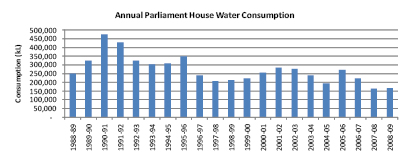
Figure 44 shows a breakdown of water
use during 2008-09. Other building water includes the cold water
used in bathrooms, kitchens and the swimming pool. The flushometer
consumption is the water used for flushing toilets and urinals.
Figure
44—Breakdown of water use during 2008-09
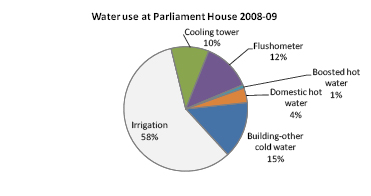
Water restrictions
ACT stage 3 water restrictions were
in place for the full year and required a reduction in water use of
35% over the equivalent season in 2005-06. For DPS, this meant a
target of 186,650kL per annum. Figure 45 shows progress in meeting
this target since the introduction of restrictions on 16 December
2006.
Figure
45—Actual water use compared to Stage 3 restrictions
target

Water saving initiatives
Savings in the landscape
The most significant water savings
have been made in the Parliament House landscape. For the third
year, overall irrigation was restricted, based on condition
monitoring of soil moisture levels.
An exemption to water restrictions
was granted on 2 December 2008 to allow the planting and irrigation
of couch grass on the sports field and one viewing strip. The
exemption was granted based on recognition that establishing
drought tolerant grass species supports long term water reduction
objectives.
Water features and the forecourt pond
The 20 external water features in
and around Parliament House remained turned off and empty during
2008-09, except for the forecourt pond.
In May 2008, for the 20th
anniversary of Parliament House, the forecourt pond was filled with
recycled water trucked in from the Lower Molonglo Water Quality
Control Centre. Using recycled water ensured that DPS did not
contravene ACT stage 3 water restrictions.
During 2008-09, a 40kL tank was
installed beneath the forecourt pond in the public carpark. The
tank stores excess recycled water delivered by truck and captures
stormwater for use in the pond. DPS plans to undertake further
projects in 2009-10 using local rainfall collection.
Energy
Parliament House is a major energy
consumer. An energy audit was undertaken in 2008-09 and has helped
identify priorities for energy improvements to assist us to deliver
the 10% reduction in energy consumption we committed to in our 2007
Energy Strategic Plan.
Altogether the recommendations of
the energy audit would exceed our energy reduction objective,
although there will need to be staged implementation of the
recommendations, and some will require further investigation to
confirm their feasibility. We have begun implementing several
recommendations, and are planning others including:
- replacement of power factor equipment;
- low-load chillers system project;
- installation of energy efficient lights
(office and carpark);
- reduced numbers of computing servers
project;
- removal of instant boiling water units;
and
- trigeneration and solar power concept
trials.
Energy consumption
DPS's energy profile consists of
energy consumed at Parliament House and transport energy, including
both passenger vehicles and maintenance vehicles ( other transport
). Figure 46 summarises this energy use in 2008-09.
Figure
46—Energy consumed at Parliament House and by transport
|
|
|
|
|
|
|
|
|
Parliament House building:
|
|
|
Electricity: non-renewable source
|
71,391
|
66,482
|
69,290
|
|
Electricity: renewable source
|
23,575
|
22,160
|
23,096
|
|
Natural gas
|
45,382
|
41,015
|
43,522
|
|
Diesel
|
480
|
200
(393)
|
443
|
|
Total (for
building)
|
140,828
|
129,856 (130,050)
|
136,351
|
|
Passenger
vehicles:
|
|
|
Automotive
diesel
|
-
|
41
|
141
|
|
Automotive
gasoline (petrol)
|
2,007
|
1556
|
1,206
|
|
E-10
(biofuel)
|
202
|
513
|
655
|
|
LPG
|
125
|
111
|
93
|
|
Total (for
passenger vehicles)
|
2,334
|
2,221
|
2095
|
|
Other
transport:
|
|
|
Automotive
diesel
|
319
|
282
|
292
|
|
Automotive
gasoline (petrol)
|
112
|
124
|
114
|
|
LPG
|
41
|
41
|
46
|
|
Total (for
other transport)
|
472
|
447
|
452
|
|
Total energy
consumption
|
143,634
|
132,522
|
138,898
|
Energy consumption in Parliament
House in 2008-09 was the second lowest recorded since the building
opened in 1988. There was an increase on 2007-08 due to that year
being an election year with fewer sitting days. The gas consumed
during 2008-09 is consistent with previous non-election years.
Energy consumed in 2008-09 was
138,898 GJ, an increase of 5% on the 132,718 GJ consumed the
previous year. Passenger and other transport energy use decreased
slightly.
Electricity and natural gas
consumption at Parliament House comprised 98%—136,351
GJ—of total energy use. Gas is used for heating, domestic hot
water and in kitchens. Electricity powers a variety of services
including office lighting, mechanical services, lifts, chillers,
computer equipment, central waste plant and boosted hot water
heating. Figure 47 shows the downward trend in electricity and gas
consumption since the building opened.
Figure
47—Annual electricity and gas consumption (in 000's of
GJ)
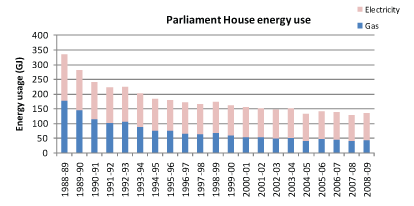
Vehicles
Parliament House's passenger vehicle
fleet consisted of 41 leased vehicles in 2008-09, including 35 SES
vehicles. Eight vehicles (seven SES) scored higher than 10 in the
Green Vehicle Guide.
Energy saving initiatives
Initiatives to conserve electricity
included the continual monitoring and adjustment of the electrical
plant load, implementing more energy-efficient lighting schemes,
and reduced airconditioning during summer.
Chilling and boiling water
During 2007-08, a review of drinking
water supply identified several locations where kettles could
provide boiling water more efficiently than instant boiling water
units and where water chillers were unwarranted. Kettles were
distributed to all Senators' and Members' suites during 2008-09. It
is proposed to remove boiling water units during 2009-10 in these
and relevant DPS areas.
Lighting
Trials continued to identify
alternatives to incandescent lamps, including those in offices and
general circulation areas.
A project to replace carpark
lighting commenced in 2008-09, and is due to be completed in the
2010-11 financial year. The revised lighting scheme and lamp types
will use substantially less energy than the existing scheme.
Energy efficient lighting design is
incorporated into all new construction work undertaken in
Parliament House. In the 2008-09 year this included major projects
such as the child care centre and the Staff Dining Room
Refurbishment.
Earth Hour
Parliament House again participated
in Earth Hour on 28 March 2009. There was an approximate 10%
reduction in energy use compared to the same hour on the previous
weekend.
All external lights were switched
off except for those lights required for safety and security
purposes—for example, lights on the flagpole.
Recycling and waste management
Waste generation and recycling
The amount of general waste
(excluding construction waste) sent to landfill in 2008-09 was 385
tonnes, which is 18% less than the 471 tonnes sent the previous
year. The quantity of recycled paper waste decreased by 16%, from
363 tonnes in 2007-08 to 306 tonnes in 2008-09. Both the decreased
waste to landfill and decreased waste paper to recycling statistics
recorded for
2008-09 are partly attributable to business activities returning to
normal after the November 2007 election—an election provides
an opportunity for an increase in maintenance work and office
clean-ups throughout Parliament House, and a
change-of-government election means a much higher than normal
increase in paper sent to recycling as offices are vacated. Figure
48 shows trends since 1998.
Figure
48—Annual waste disposed to landfill and recycled
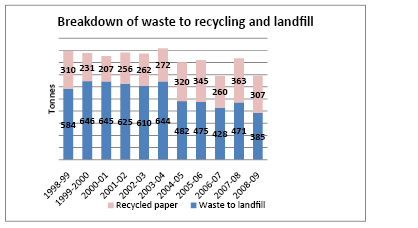
Landscape waste
The preferred method for disposing
of green waste at Parliament House is to chip the material
on-site and re-use it in the landscape. The amount of chipped
material is not recorded. When waste generated in the landscape
cannot be chipped
on-site—due to volume, composition or resources—then
the material is taken off-site to be recycled or to landfill.
During 2008-09, 187 tonnes of
landscape waste was generated from the Parliament House landscape.
Only 3.2 tonnes was sent to landfill during the year. This was
mixed rubble and soil from a small project to construct a ramp to a
soil bin in the ministerial car park which could only be disposed
of at the landfill.
Figure 49 shows annual trends in
landscape waste and recycling rates. The peak in landscape waste
during 2005-06 was because of a turf replacement project on the
Grass Ramps.
Figure
49—Annual quantity of landscape waste
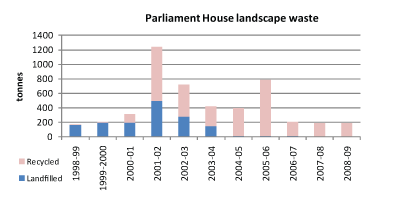
Waste management initiatives
Recycling facilities and co-mingled recycling
DPS provides facilities to recycle
paper, cardboard, printer cartridges, lamps, used oil, grease,
batteries, landscape and metal waste. From 4 February 2008, DPS
expanded these facilities to provide building occupants the option
of recycling co-mingled wastes, so 2008-09 was the first full year
that the voluntary co-mingled recycling scheme was available.
At 30 June 2009, 96 tonnes of
co-mingled waste had been collected and recycled, compared to 56
tonnes the previous year. An objective of the DPS Waste Strategic
Plan is to make the recycling scheme mandatory.
Other waste initiatives
Putrescible waste (ie vegetable,
fruit, meat, other food scraps and handtowels) from Parliament
House currently goes to landfill. In consultation with the waste
contractor DPS is considering options for recovering and recycling
putrescible waste.
DPS is now procuring 100% recycled
content office paper, at a cost increase of approximately 27%. We
aimed to reduce paper use by 21% to offset the additional cost. In
the end we achieved a reduction of 13%, or a little over 1,000
reams of paper. Initiatives such as the new Electronic Document
Records Management System provide the potential for further
reductions in paper use. Regular reporting to branches on paper use
coupled with reminders of methods to save paper such as double
sided printing and reducing the number of printed copies of
documents also helped to reduce paper use, and will continue.
Emissions and
effluents
Greenhouse gas emissions
During 2008-09, 22,965 tonnes of
carbon dioxide equivalent (CO2e) were generated from energy
consumption at Parliament House. Greenhouse emissions are described
in Figure 50.
Figure
50—Parliament House emissions (direct and indirect, including
SES and operational vehicle fleets)
|
|
|
|
|
|
|
Scope 1
|
Emissions at the source of the activity
(eg emitted from gas and fuels used at Parliament House and by
vehicles)
|
2,587
|
2,318
|
2,436
|
|
Scope 2
|
Emissions generated elsewhere (eg by the
power plants that produce the electricity used at Parliament
House)
|
17,129
|
16,520
|
17,253
|
|
Scope 3
|
Indirect emissions, meaning emissions
generated during the delivery of electricity, gas and fuel to
Parliament House, which DPS has little control over.
|
4,307
|
3,916
|
3,276
|
|
Scopes 1 & 2
|
DPS has direct responsibility for these
emissions.
|
19,716
|
18,838
|
19,689
|
|
Scopes 1,2 & 3
|
Direct and indirect emissions.
|
24,023[31]
|
22,754
|
22,965
|
Figure 51 shows annual greenhouse
gas emissions since Parliament House opened in 1988. Purchasing 25%
of our electricity from renewable sources has helped to achieve
continuing record low emissions, although the low energy
consumption of the 2007-08 election year remains the best ever.
Figure
51—Annual greenhouse gas emissions from electricity and
gas

DPS's membership of the Greenhouse
Challenge Plus program ceased when the project was discontinued on
1 July 2009. DPS had been a member since 1997.
Ozone depleting substances
Parliament House uses refrigerants
that contain ozone depleting substances. These are used for:
- chillers, which provide cooling for the
building's airconditioning;
- cool rooms;
- freezers; and
- refrigerators.
Figure 52 shows the type and ozone
depletion potential of refrigerants purchased in 2008-09.
Figure
52—Type of refrigerant use
|
|
|
|
|
R404A
|
0
|
3,260
|
|
R409A
|
0.048
|
1,560
|
|
SPE34E
|
0
|
1,280
|
|
R134A
|
0
|
1,300
|
|
R410A
|
0
|
2,000
|
|
R22
|
0.034
|
1,780
|
Air pollutants-NOx, SOx and particulates
The combustion of natural gas for
heating, hot water and cooking purposes generates oxides of
nitrogen (NOx), oxides of sulphur (SOx) and other air pollutants.
Each year, DPS reports on these emissions to the National Pollution
Inventory (www.npi.gov.au).
Figure 53—Emissions of air
pollutants from natural gas consumption lists these emissions for
2008-09. Parliament House gas combustion increased by 6% in
2008-09, and as a result air pollution emissions increased in
proportion.
Figure
53—Emissions of air pollutants from natural gas
consumption
|
|
|
|
|
Carbon monoxide
|
1,680
|
1,782
|
|
Oxides of nitrogen
|
1,993
|
2115
|
|
Particulate matter (PM10)
|
148
|
157
|
|
Particulate matter (PM2.5)
|
148
|
157
|
|
Total Volatile organic compounds
|
110
|
116
|
|
Sulphur dioxide
|
32
|
34
|
|
Polycyclic aromatic hydrocarbons
|
<1 (0.013)
|
<1 (0.014)
|
Discharges to
water
Sewage from Parliament House is
required under a trade waste agreement to be equivalent to domestic
strength. To ensure these requirements are met, there is a:
- grease trap on each kitchen drain;
- coalescing plate filter on the vehicle wash
down bay (to prevent oil from entering the sewer); and
- system to remove paint solids from paint
brush washing facilities before they enter the sewer.
Significant spills of
chemicals, oils, and fuels
In 2008-09 there were no significant
spills of chemicals, oils or fuels from Parliament House.